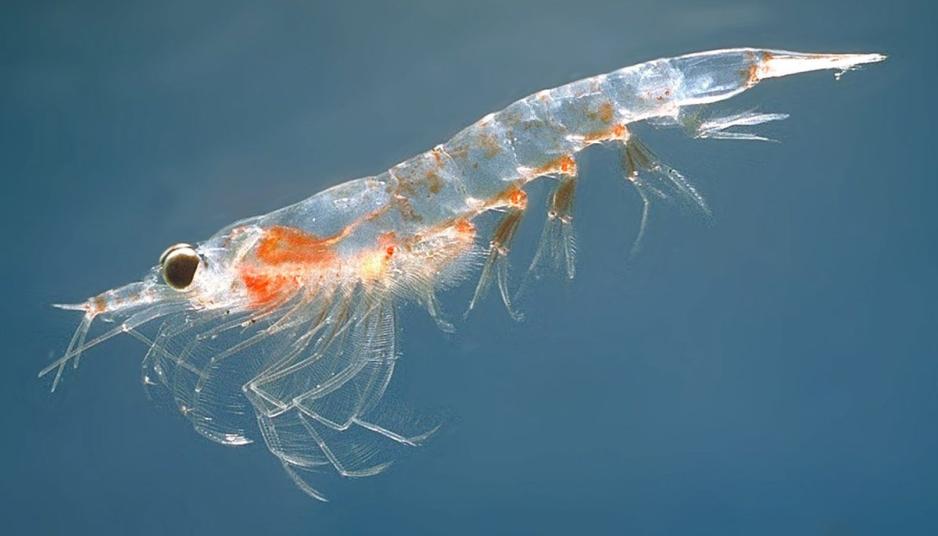Op-ed: China and Norway Are Central to Pivotal Decisions in Southern Ocean Fishing

The largest and most common krill is called Norwegian big krill, Meganyctiphanes Norvegica. It can be up to 4.5 cm long. (Photo: Øystein Paulsen, Great Norwegian Encyclopedia)
As the organization that manages Southern Ocean fisheries – The Commission for the Conservation of Antarctic Marine Living Resources (CCAMLR) – prepares to hold its annual meeting in Hobart, Australia in October, major questions need to be addressed by its 29 Members.
Of particular importance will be both how work proceeds on establishment of new large-scale marine protected areas, and new directions in krill management.
As it happens, these two issues have become politically intertwined, and it appears that two countries will be particularly influential in the result – China and Norway.
A major focus of CCAMLR’s work in recent years has been to establish a network of marine protected areas. CCAMLR functions in part as a regional fisheries management organization, although it has a broader mandate related to conservation.
It is the body that has authority to establish MPAs in the Southern Ocean, and key nations like Norway, China, Russia, Japan and the USA, as well as the EU, are members.
Since 2016, China and Russia have refused to agree to any new Antarctic MPAs
CCAMLR operates on the basis of consensus of its members, and thus if even a single member objects to an initiative it fails. In 2016, consensus was reached to establish what was and still is the largest marine protected area in the world, in Antarctica’s Ross Sea.
The Ross Sea MPA is about the size of Mexico (or four times the size of Spain). However, since 2016, China and Russia have refused to agree to any new Antarctic MPAs and have tried to block efforts to implement existing ones.
In the case of China, this is a bit surprising in that China has expressed support for the global objective to conserve 30 percent of the world’s ocean by 2030.
Moreover, China, like most countries, has expressed support for a new UN high seas treaty on biodiversity that seeks to promote MPAs.
Norway has supported new MPAs at CCAMLR. Indeed it has cosponsored proposals for MPAs in East Antarctica and in the Weddell Sea.
Also read (The text continues)
Krill will also be on the agenda at the CAMLR Commission in October. Krill is an abundant resource that is crucial to the Antarctic ecosystem and is at the base of the food chain, but how much is taken and where can have impacts on other species.
There is continuing demand for krill for fish farm feed, pet food and dietary supplements, and fishing nations have responded.
Krill management was the reason that CCAMLR was established in the first place in 1982, at a time when the Soviet Union had a strong interest and ability in krill fishing.
Over time, based on scientific advice, the Commission set an overall catch limit for krill in the key subareas where fishing currently takes place (in the Scotia Sea region of the South Atlantic Sector, referred to within CCAMLR as Area 48), setting a “trigger level” of 620,000 tonnes, and later establishing an interim distribution of that trigger level among the subareas so that predators like penguins, seals and whales would not be disproportionately affected by large amounts of fishing in localized areas.
That distribution was established 16 years old, and it has been rolled over unchanged three times since 2021.
Norway has notified 4 vessels, and China 5.
With continued commercial interest in increasing the krill catch and facing outdated rules, CCAMLR members have expressed a renewed urgency to come up with an updated krill fisheries management approach.
Catches of krill have been reported by 19 nations overall. In the period 2013-2023, five Members have fished for krill, 63.6% of the total catch has been taken by Norway, 17.1% by China and 11.4% by the Republic of Korea.
For the 2024 fishing season, 6 Members notified their intention to fish for krill with a total of 14 vessels. Among these, Norway has notified 4 vessels, and China 5.
These two policy imperatives – new MPAs and a revised krill management framework – have led to an effort among states to “harmonize” work in these two areas (on the MPA side at least with respect to the proposed MPA that is closest to where krill fishing is occurring in Area 48).
Indeed, in July CCAMLR held a harmonization symposium in Incheon, S. Korea so that experts could work on the details.
An interesting element of this harmonization work is the idea, widely held, that allowing an increase in krill catch could entice China into agreeing to one or more MPAs that it has so far staunchly opposed.
Also read (the text continues)
If there is a “deal” to be had in this way, a major part of the negotiation will be how much additional krill catch will China insist on in exchange for agreeing to MPAs.
This question that relates to satisfying the commercial interests in the krill fishery will be of considerable importance not just to China, but also to Norway.
Thus, a question is how Norway will approach these negotiations. Will it want to act as a broker among the members?
How will it react if China demands a sharp increase in krill catch, which may be consistent with Norway’s commercial interests but if implemented could create challenges for conservation objectives?
Will Norway press China to agree to the MPAs, as a large number of others, including the EU and USA, plan to do.
It isn’t clear that the Commission will be able to resolve these interrelated issues this year, but pressure is rising to find solutions. It will be interesting to see what can be negotiated.





